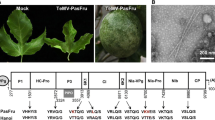Abstract
We previously reported a possible potyvirus isolated from Mirabilis jalapa that exhibited a high degree of sequence similarity to Basella rugose mosaic virus (BaRMV) in the region encoding the coat protein (CP). Here, we present the complete genome sequence of this isolate, comprising a 9666-nucleotide-long monopartite ssRNA (excluding the poly(A) tail) encoding a 3080-amino-acid polyprotein. The CP region showed a high degree of nucleotide sequence similarity to three BaRMV isolates (75.2–77.3% identity), while other regions showed nucleotide sequence identity values (48.8–73.7%) below the species demarcation threshold proposed by the ICTV. Therefore, we propose that this isolate be considered a new member of the genus Potyvirus, tentatively named “mirabilis crinkle mosaic virus” (MiCMV).

Similar content being viewed by others
References
Wang JG, Peng JJ, Chen HR, Chen SY (2012) First report of Basella rugose mosaic virus infecting four o’clock (Mirabilis jalapa) in China. Plant Dis 96:294
Adams MJ, Antoniw JF, Fauquet CM (2005) Molecular criteria for genus and species discrimination within the family Potyviridae. Arch Virol 150:459–479
Wylie SJ, Adams M, Chalam C, Kreuze J, López-Moya JJ, Ohshima K, Praveen S, Rabenstein F, Stenger D, Wang AM, Zerbini FM, ICTV Report Consortium (2017) ICTV virus taxonomy profile: Potyviridae. J Gen Virol 98:352–354
Adams MJ, Antoniw JF, Beaudoin F (2005) Overview and analysis of the polyprotein cleavage sites in the family Potyviridae. Mol Plant Pathol 6:471–487
Chen J, Chen JP, Adams MJ (2001) A universal PCR primer to detect members of the Potyviridae and its use to examine the taxonomic status of several members of the family. Arch Virol 146:757–766
Chen J, Chen JP (2002) Determination of genome sequence of potyviruses by degenerated PCR and RACE method. Chin J Virol 18:371–374
Tamura K, Stecher G, Peterson D, Filipski A, Kumar S (2013) MEGA6: molecular evolutionary genetics analysis version 6.0. Mol Biol Evol 30:2725–2729
Martin DP, Williamson C, Posada D (2005) RDP2: recombination detection and analysis from sequence alignments. Bioinformatics 21:260–262
Fiallo-Olive E, Zerbini FM, Navas-Castillo J (2015) Complete nucleotide sequences of two new begomoviruses infecting the wild malvaceous plant Melochia sp. in Brazil. Arch Virol 160:3161–3164
Atreya PL, Lopez-Moya JJ, Chu M, Atreya CD, Pirone TP (1995) Mutational analysis of the coat protein N-terminal amino acids involved in potyvirus transmission by aphids. J Gen Virol 76:265–270
Funding
This study was funded by a research grant from the National Natural Science Foundation of China (Grant 31660038).
Author information
Authors and Affiliations
Corresponding authors
Ethics declarations
Conflict of interest
All authors declare that they have no conflict of interest.
Ethical approval
This article does not contain any study with human participants or animals performed by any of the authors.
Additional information
Handling Editor: F. Murilo Zerbini.
Publisher's Note
Springer Nature remains neutral with regard to jurisdictional claims in published maps and institutional affiliations.
Electronic supplementary material
Below is the link to the electronic supplementary material.
Rights and permissions
About this article
Cite this article
Zhang, P., Li, X., Ren, L. et al. A potyvirus isolated from Mirabilis jalapa in China represents a new species. Arch Virol 165, 505–507 (2020). https://doi.org/10.1007/s00705-019-04453-0
Received:
Accepted:
Published:
Issue Date:
DOI: https://doi.org/10.1007/s00705-019-04453-0




